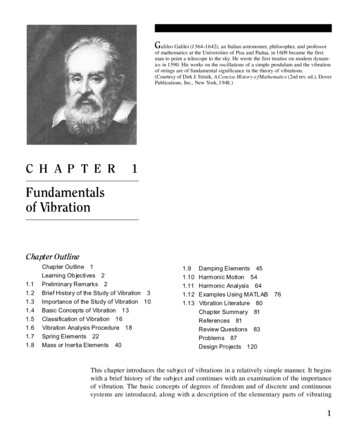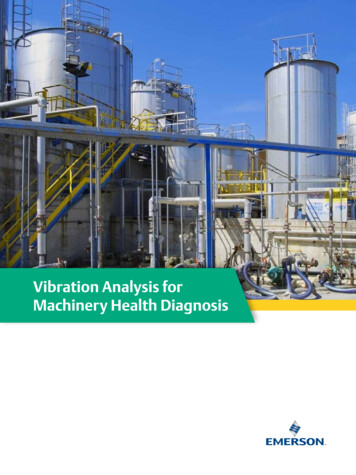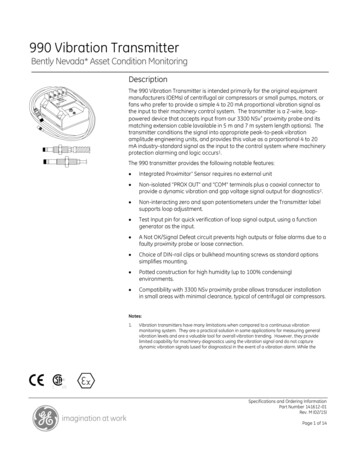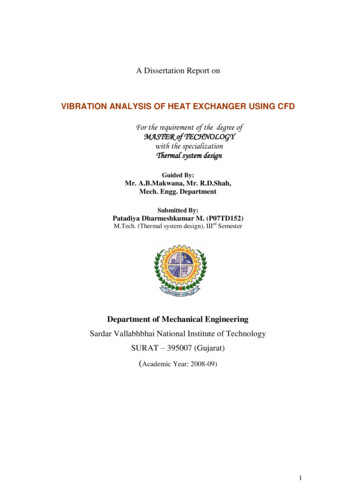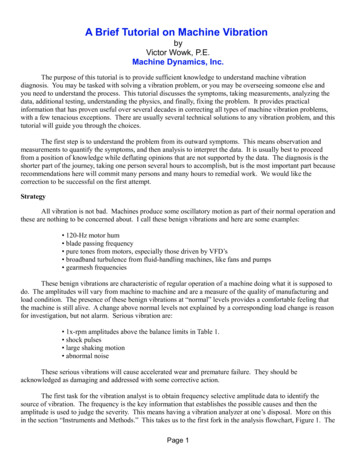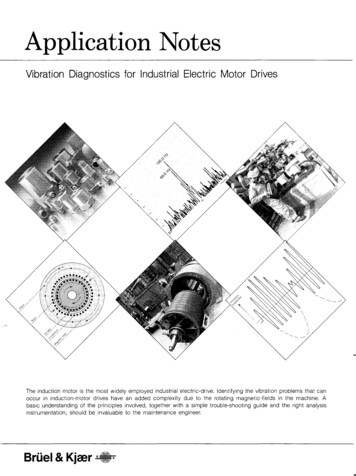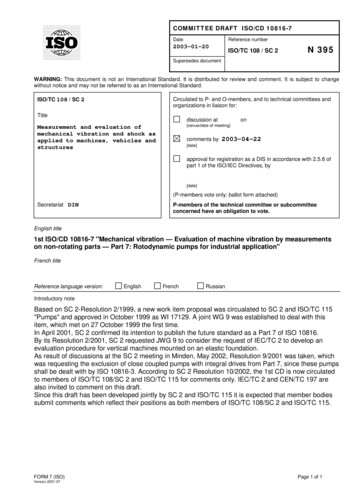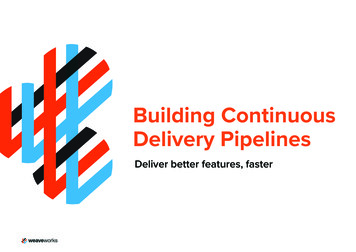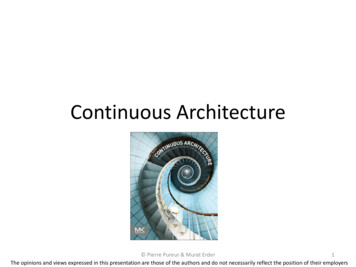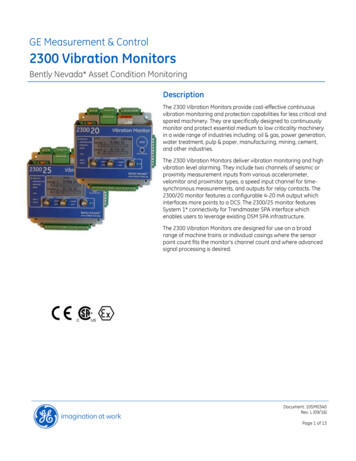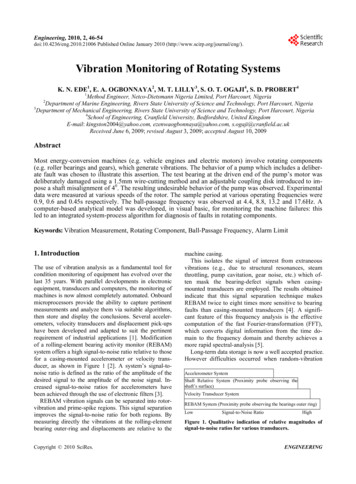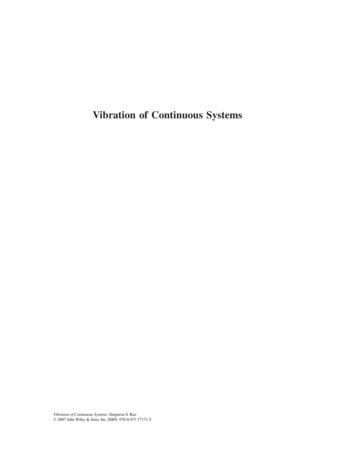
Transcription
Vibration of Continuous SystemsVibration of Continuous Systems. Singiresu S. Rao 2007 John Wiley & Sons, Inc. ISBN: 978-0-471-77171-5
Vibration of ContinuousSystemsSingiresu S. RaoProfessor and ChairmanDepartment of Mechanical and Aerospace EngineeringUniversity of MiamiCoral Gables, FloridaJOHN WILEY & SONS, INC.
This book is printed on acid-free paper.c 2007 by John Wiley & Sons, Inc. All rights reserved.Copyright Published by John Wiley & Sons, Inc., Hoboken, New JerseyPublished simultaneously in Canada.No part of this publication may be reproduced, stored in a retrieval system, or transmitted in any form orby any means, electronic, mechanical, photocopying, recording, scanning, or otherwise, except aspermitted under Section 107 or 108 of the 1976 United States Copyright Act, without either the priorwritten permission of the Publisher, or authorization through payment of the appropriate per-copy fee tothe Copyright Clearance Center, Inc., 222 Rosewood Drive, Danvers, MA 01923, 978-750-8400, fax978-646-8600, or on the web at www.copyright.com. Requests to the Publisher for permission should beaddressed to the Permissions Department, John Wiley & Sons, Inc., 111 River Street, Hoboken, NJ 07030,201-748-6011, fax 201-748-6008, or online at http://www.wiley.com/go/permissions.Limit of Liability/Disclaimer of Warranty: While the publisher and author have used their best efforts inpreparing this book, they make no representations or warranties with respect to the accuracy orcompleteness of the contents of this book and specifically disclaim any implied warranties ofmerchantability or fitness for a particular purpose. No warranty may be created or extended by salesrepresentatives or written sales materials. The advice and strategies contained herein may not be suitablefor your situation. You should consult with a professional where appropriate. Neither the publisher norauthor shall be liable for any loss of profit or any other commercial damages, including but not limited tospecial, incidental, consequential, or other damages.For general information on our other products and services, or technical support, please contact ourCustomer Care Department within the United States at 800-762-2974, outside the United States at317-572-3993 or fax 317-572-4002.Wiley also publishes its books in a variety of electronic formats. Some content that appears in print maynot be available in electronic books. For more information about Wiley products, visit our Web site athttp://www.wiley.com.Library of Congress Cataloging-in-Publication Data:Rao, S. S.Vibration of Continuous Systems / Singiresu S. Rao.p. cm.Includes index.ISBN-13 978-0-471-77171-5 (cloth)ISBN-10 0-471-77171-6 (cloth)1. Vibration–Textbooks. 2. Structural dynamics–Textbooks.I. Title.TA355.R378 2007624.1 71–dc222006008775Printed in the United States of America10 9 8 7 6 5 4 3 2 1
To Lord Sri Venkateswara
ContentsPrefaceSymbols1xvxix2.2.3Introduction: Basic Concepts andTerminology11.11.21.3Concept of Vibration1Importance of Vibration4Origins and Developments in Mechanics andVibration51.4History of Vibration of ContinuousSystems81.5Discrete and Continuous Systems111.6Vibration Problems151.7Vibration Analysis161.8Excitations171.9Harmonic Functions181.9.1 Representation of HarmonicMotion181.9.2 Definitions and Terminology211.10Periodic Functions and Fourier Series241.11Nonperiodic Functions and FourierIntegrals261.12Literature on Vibration of bration of Discrete Systems: BriefReview33Vibration of a Single-Degree-of-FreedomSystem332.1.1 Free Vibration332.1.2 Forced Vibration under HarmonicForce362.1.3 Forced Vibration under GeneralForce41Vibration of Multidegree-of-FreedomSystems432.2.1 Eigenvalue Problem452.2.2 Orthogonality of Modal VectorsFree Vibration Analysis of anUndamped System Using ModalAnalysis472.2.4 Forced Vibration Analysis of anUndamped System Using ModalAnalysis522.2.5 Forced Vibration Analysis of a Systemwith Proportional Damping532.2.6 Forced Vibration Analysis of a Systemwith General Viscous Damping542.3Recent Introduction68Newton’s Second Law of Motion68D’Alembert’s Principle69Equation of Motion of a Bar in AxialVibration693.5Equation of Motion of a Beam in TransverseVibration713.6Equation of Motion of a Plate in TransverseVibration733.6.1 State of Stress753.6.2 Dynamic Equilibrium Equations753.6.3 Strain–Displacement Relations763.6.4 Moment–DisplacementRelations783.6.5 Equation of Motion in Terms ofDisplacement783.6.6 Initial and Boundary Conditions793.7Additional Contributions80References80Problems81446Derivation of Equations: EquilibriumApproach684.14.2Derivation of Equations: VariationalApproach85Introduction85Calculus of a Single Variable85vii
viiiContents4.34.44.5Calculus of Variations86Variation Operator89Functional with Higher-OrderDerivatives914.6Functional with Several DependentVariables934.7Functional with Several IndependentVariables954.8Extremization of a Functional withConstraints964.9Boundary Conditions1004.10Variational Methods in SolidMechanics1044.10.1 Principle of Minimum PotentialEnergy1044.10.2 Principle of Minimum ComplementaryEnergy1054.10.3 Principle of Stationary ReissnerEnergy1064.10.4 Hamilton’s Principle1074.11Applications of Hamilton’s Principle1154.11.1 Equation of Motion for TorsionalVibration of a Shaft (FreeVibration)1154.11.2 Transverse Vibration of a ThinBeam1164.12Recent 5.45.55.65.4.1One-Dimensional Systems5.4.2General Continuous Systems5.4.3Orthogonality ofEigenfunctions133Method of UndeterminedCoefficients1345.5.2Iterative Method5.5.3Rayleigh–Ritz Method5.5.4Galerkin’s Method5.5.5Collocation Method5.5.6Numerical Integration MethodRecent Contributions132133Solution of Integral 7148149Solution Procedure: Eigenvalue and ModalAnalysis Approach1516.1Introduction6.2General Problem6.3Solution of Homogeneous Equations:Separation-of-Variables Technique1536.4Derivation of Equations: Integral EquationApproach123Introduction123Classification of Integral Equations1235.2.1 Classification Based on the NonlinearAppearance of φ(t)1235.2.2 Classification Based on the Location ofUnknown Function φ(t)1245.2.3 Classification Based on the Limits ofIntegration1245.2.4 Classification Based on the ProperNature of an Integral125Derivation of Integral Equations1255.3.1 Direct Method1255.3.2 Derivation from the DifferentialEquation of Motion127General Formulation of the EigenvalueProblem1306.5151151Sturm–Liouville Problem1546.4.1Classification of Sturm–LiouvilleProblems1556.4.2Properties of Eigenvalues andEigenfunctions160General Eigenvalue Problem6.5.1Self-Adjoint EigenvalueProblem1636.5.2Orthogonality ofEigenfunctions6.5.3163165Expansion Theorem1666.6Solution of NonhomogeneousEquations1676.7Forced Response of Viscously DampedSystems1696.8Recent ContributionsReferencesProblems172173171146
Contents7Solution Procedure: Integral TransformMethods1747.17.2Introduction174Fourier Transforms1757.2.1 Fourier Series1757.2.2 Fourier Transforms1767.2.3 Fourier Transform of Derivatives ofFunctions1787.2.4 Finite Sine and Cosine FourierTransforms1787.3Free Vibration of a Finite String1817.4Forced Vibration of a Finite String1837.5Free Vibration of a Beam1857.6Laplace Transforms1887.6.1 Properties of LaplaceTransforms1897.6.2 Partial Fraction Method1917.6.3 Inverse Transformation1937.7Free Vibration of a String of FiniteLength1947.8Free Vibration of a Beam of FiniteLength1977.9Forced Vibration of a Beam of FiniteLength1987.10Recent 8.48.5Transverse Vibration of Strings205Introduction205Equation of Motion2058.2.1 Equilibrium Approach2058.2.2 Variational Approach207Initial and Boundary Conditions209Free Vibration of an Infinite String2108.4.1 Traveling-Wave Solution2108.4.2 Fourier Transform–BasedSolution2138.4.3 Laplace Transform–BasedSolution215Free Vibration of a String of FiniteLength2178.5.1 Free Vibration of a String with BothEnds Fixed218ix8.6Forced Vibration2278.7Recent nal Vibration of Bars2349.19.2Introduction234Equation of Motion Using SimpleTheory2349.2.1 Using Newton’s Second Law ofMotion2349.2.2 Using Hamilton’s Principle2359.3Free Vibration Solution and NaturalFrequencies2369.3.1 Solution Using Separation ofVariables2379.3.2 Orthogonality ofEigenfunctions2469.3.3 Free Vibration Response due to InitialExcitation2499.4Forced Vibration2549.5Response of a Bar Subjected to LongitudinalSupport Motion2579.6Rayleigh Theory2589.6.1 Equation of Motion2589.6.2 Natural Frequencies and ModeShapes2599.7Bishop’s Theory2609.7.1 Equation of Motion2609.7.2 Natural Frequencies and ModeShapes2629.7.3 Forced Vibration Using ModalAnalysis2649.8Recent Contributions267References268Problems26810 Torsional Vibration of Shafts10.110.210.3271Introduction271Elementary Theory: Equation ofMotion27110.2.1 Equilibrium Approach27110.2.2 Variational Approach272Free Vibration of Uniform Shafts276
xContents10.3.1 Natural Frequencies of a Shaft withBoth Ends Fixed27710.3.2 Natural Frequencies of a Shaft withBoth Ends Free27810.3.3 Natural Frequencies of a Shaft Fixed atOne End and Attached to a TorsionalSpring at the Other27910.4Free Vibration Response due to InitialConditions: Modal Analysis28910.5Forced Vibration of a Uniform Shaft: ModalAnalysis29210.6Torsional Vibration of Noncircular Shafts:Saint-Venant’s Theory29510.7Torsional Vibration of Noncircular Shafts,Including Axial Inertia29910.8Torsional Vibration of Noncircular Shafts:Timoshenko–Gere Theory30010.9Torsional Rigidity of NoncircularShafts30310.10 Prandtl’s Membrane Analogy30810.11 Recent Contributions313References314Problems31511 Transverse Vibration of uction317Equation of Motion: Euler–BernoulliTheory317Free Vibration Equations322Free Vibration Solution325Frequencies and Mode Shapes of UniformBeams32611.5.1 Beam Simply Supported at BothEnds32611.5.2 Beam Fixed at Both Ends32811.5.3 Beam Free at Both Ends33011.5.4 Beam with One End Fixed and theOther Simply Supported33111.5.5 Beam Fixed at One End and Free atthe Other333Orthogonality of Normal Modes339Free Vibration Response due to InitialConditions341Forced Vibration344Response of Beams under MovingLoads35011.10Transverse Vibration of Beams Subjected toAxial Force35211.10.1 Derivation of Equations35211.10.2 Free Vibration of a UniformBeam35511.11 Vibration of a Rotating Beam35711.12 Natural Frequencies of Continuous Beams onMany Supports35911.13 Beam on an Elastic Foundation36411.13.1 Free Vibration36411.13.2 Forced Vibration36611.13.3 Beam on an Elastic FoundationSubjected to a Moving Load36711.14 Rayleigh’s Theory36911.15 Timoshenko’s Theory37111.15.1 Equations of Motion37111.15.2 Equations for a Uniform Beam37611.15.3 Natural Frequencies ofVibration37711.16 Coupled Bending–Torsional Vibration ofBeams38011.16.1 Equations of Motion38111.16.2 Natural Frequencies ofVibration38311.17 Transform Methods: Free Vibration of anInfinite Beam38511.18 Recent Contributions387References389Problems39012 Vibration of tion393Equations of Motion of a Circular Ring39312.2.1 Three-Dimensional Vibrations of aCircular Thin Ring39312.2.2 Axial Force and Moments in Terms ofDisplacements39512.2.3 Summary of Equations andClassification of Vibrations397In-Plane Flexural Vibrations of Rings39812.3.1 Classical Equations of Motion39812.3.2 Equations of Motion That IncludeEffects of Rotary Inertia and ShearDeformation399
Contents12.4Flexural Vibrations at Right Angles to thePlane of a Ring40212.4.1 Classical Equations of Motion40212.4.2 Equations of Motion That IncludeEffects of Rotary Inertia and ShearDeformation40312.5Torsional Vibrations40612.6Extensional Vibrations40712.7Vibration of a Curved Beam with VariableCurvature40812.7.1 Thin Curved Beam40812.7.2 Curved Beam Analysis, Including theEffect of Shear Deformation41412.8Recent Contributions416References418Problems41913 Vibration of Membranes13.113.2420Introduction420Equation of Motion42013.2.1 Equilibrium Approach42013.2.2 Variational Approach42313.3Wave Solution42513.4Free Vibration of RectangularMembranes42613.4.1 Membrane with ClampedBoundaries42813.4.2 Mode Shapes43013.5Forced Vibration of RectangularMembranes43813.5.1 Modal Analysis Approach43813.5.2 Fourier Transform Approach44113.6Free Vibration of Circular Membranes44413.6.1 Equation of Motion44413.6.2 Membrane with a ClampedBoundary44613.6.3 Mode Shapes44713.7Forced Vibration of CircularMembranes44813.8Membranes with Irregular Shapes45213.9Partial Circular Membranes45313.10 Recent Contributions453References454Problems45514 Transverse Vibration of Plates14.114.2xi457Introduction457Equation of Motion: Classical PlateTheory45714.2.1 Equilibrium Approach45714.2.2 Variational Approach45814.3Boundary Conditions46514.4Free Vibration of Rectangular Plates47114.4.1 Solution for a Simply SupportedPlate47314.4.2 Solution for Plates with OtherBoundary Conditions47414.5Forced Vibration of Rectangular Plates47914.6Circular Plates48514.6.1 Equation of Motion48514.6.2 Transformation of Relations48614.6.3 Moment and Force Resultants48814.6.4 Boundary Conditions48914.7Free Vibration of Circular Plates49014.7.1 Solution for a Clamped Plate49214.7.2 Solution for a Plate with a FreeEdge49314.8Forced Vibration of Circular Plates49514.8.1 Harmonic Forcing Function49514.8.2 General Forcing Function49714.9Effects of Rotary Inertia and ShearDeformation49914.9.1 Equilibrium Approach49914.9.2 Variational Approach50514.9.3 Free Vibration Solution51114.9.4 Plate Simply Supported on All FourEdges51314.9.5 Circular Plates51514.9.6 Natural Frequencies of a ClampedCircular Plate52014.10 Plate on an Elastic Foundation52114.11 Transverse Vibration of Plates Subjected toIn-Plane Loads52314.11.1 Equation of Motion52314.11.2 Free Vibration52814.11.3 Solution for a Simply SupportedPlate52814.12 Vibration of Plates with VariableThickness52914.12.1 Rectangular Plates529
xiiContents14.12.2 Circular Plates53114.12.3 Free Vibration Solution14.13 Recent Contributions535References537Problems53915 Vibration of troduction and Shell Coordinates54115.1.1 Theory of Surfaces54115.1.2 Distance between Points in the MiddleSurface before Deformation54215.1.3 Distance between Points Anywhere inthe Thickness of a Shell beforeDeformation54715.1.4 Distance between Points Anywhere inthe Thickness of a Shell afterDeformation549Strain–Displacement Relations552Love’s Approximations556Stress–Strain Relations562Force and Moment Resultants563Strain Energy, Kinetic Energy, and Work Doneby External Forces57115.6.1 Strain Energy57115.6.2 Kinetic Energy57315.6.3 Work Done by External Forces573Equations of Motion from Hamilton’sPrinciple57515.7.1 Variation of Kinetic Energy57515.7.2 Variation of Strain Energy57615.7.3 Variation of Work Done by ExternalForces57715.7.4 Equations of Motion57715.7.5 Boundary Conditions579Circular Cylindrical Shells58215.8.1 Equations of Motion58315.8.2 Donnell–Mushtari–VlasovTheory58415.8.3 Natural Frequencies of VibrationAccording to DMV Theory58415.8.4 Natural Frequencies of TransverseVibration According to DMVTheory58615.8.5 Natural Frequencies of VibrationAccording to Love’s Theory587Equations of Motion of Conical and SphericalShells59115.9.1 Circular Conical Shells59115.9.2 Spherical Shells59115.10 Effect of Rotary Inertia and ShearDeformation59215.10.1 Displacement Components59215.10.2 Strain–Displacement Relations59315.10.3 Stress–Strain Relations59415.10.4 Force and Moment Resultants59415.10.5 Equations of Motion59515.10.6 Boundary Conditions59615.10.7 Vibration of Cylindrical Shells59715.10.8 Natural Frequencies of Vibration ofCylindrical Shells59815.10.9 Axisymmetric Modes60115.11 Recent Contributions603References604Problems60516 Elastic Wave tion607One-Dimensional Wave Equation607Traveling-Wave Solution60816.3.1 D’Alembert’s Solution60816.3.2 Two-Dimensional Problems61016.3.3 Harmonic Waves610Wave Motion in Strings61116.4.1 Free Vibration and HarmonicWaves61116.4.2 Solution in Terms of InitialConditions61316.4.3 Graphical Interpretation of theSolution614Reflection of Waves in One-DimensionalProblems61716.5.1 Reflection at a Fixed or RigidBoundary61716.5.2 Reflection at a Free Boundary618Reflection and Transmission of Waves at theInterface of Two Elastic Materials61916.6.1 Reflection at a Rigid Boundary62216.6.2 Reflection at a Free Boundary623Compressional and Shear Waves62316.7.1 Compressional or P Waves623
Contents16.7.2 Shear or S Waves625Flexural Waves in Beams628Wave Propagation in an Infinite ElasticMedium63116.9.1 Dilatational Waves63116.9.2 Distortional Waves63216.9.3 Independence of Dilatational andDistortional Waves63216.10 Rayleigh or Surface Waves63516.11 Recent Contributions643References644Problems64516.816.917 Approximate Analytical Rayleigh’s Quotient648Rayleigh’s Method650Rayleigh–Ritz Method661Assumed Modes Method670Weighted Residual Methods673Galerkin’s Method67364717.8Collocation Method68017.9Subdomain Method68417.10 Least Squares Method68617.11 Recent Contributions693References695Problems696A Basic Equations of lacement RelationsRotations702Stress–Strain Relations703Equations of Motion in Terms ofStresses704Equations of Motion in Terms ofDisplacements705B Laplace and Fourier TransformsIndex700713700707xiii
PrefaceThis book covers analytical methods of vibration analysis of continuous structuralsystems, including strings, bars, shafts, beams, circular rings and curved beams, membranes, plates, and shells. The propagation of elastic waves in structures and solidbodies is also introduced. The objectives of the book are (1) to make a methodical andcomprehensive presentation of the vibration of various types of structural elements,(2) to present the exact analytical and approximate analytical methods of analysis, and(3) to present the basic concepts in a simple manner with illustrative examples.Continuous structural elements and systems are encountered in many branchesof engineering, such as aerospace, architectural, chemical, civil, ocean, and mechanical engineering. The design of many structural and mechanical devices and systemsrequires an accurate prediction of their vibration and dynamic performance characteristics. The methods presented in the book can be used in these applications. The book isintended to serve as a textbook for a dual-level or first graduate-level course on vibrations or structural dynamics. More than enough material is included for a one-semestercourse. The chapters are made as independent and self-contained as possible so thata course can be taught by selecting appropriate chapters or through equivalent selfstudy. A successful vibration analysis of continuous structural elements and systemsrequires a knowledge of mechanics of materials, structural mechanics, ordinary and partial differential equations, matrix methods, variational calculus, and integral equations.Applications of these techniques are presented throughout. The selection, arrangement,and presentation of the material has been made based on the lecture notes for a coursetaught by the author. The contents of the book permit instructors to emphasize a variety of topics, such as basic mathematical approaches with simple applications, barsand beams, beams and plates, or plates and shells. The book will also be useful as areference book for practicing engineers, designers, and vibration analysts involved inthe dynamic analysis and design of continuous systems.Organization of the BookThe book is organized into 17 chapters and two appendixes. The basic concepts andterminology used in vibration analysis are introduced in Chapter 1. The importance,origin, and a brief history of vibration of continuous systems are presented. The difference between discrete and continuous systems, types of excitations, description ofharmonic functions, and basic definitions used in the theory of vibrations and representation of periodic functions in terms of Fourier series and the Fourier integralare discussed. Chapter 2 provides a brief review of the theory and techniques usedin the vibration analysis of discrete systems. Free and forced vibration of single- andmultidegree-of-freedom systems are outlined. The eigenvalue problem and its role inthe modal analysis used in the free and forced vibration analysis of discrete systemsare discussed.xv
xviPrefaceVarious methods of formulating vibration problems associated with continuoussystems are presented in Chapters 3, 4, and 5. The equilibrium approach is presentedin Chapter 3. Use of Newton’s second law of motion and D’Alembert’s principle isoutlined, with application to different types of continuous elements. Use of the variational approach in deriving equations of motion and associated boundary conditions isdescribed in Chapter 4. The basic concepts of calculus of variations and their applicationto extreme value problems are outlined. The variational methods of solid mechanics,including the principles of minimum potential energy, minimum complementary energy,stationary Reissner energy, and Hamilton’s principle, are presented. The use of Hamilton’s principle in the formulation of continuous systems is illustrated with torsionalvibration of a shaft and transverse vibration of a thin beam. The integral equationapproach for the formulation of vibration problems is presented in Chapter 5. A briefoutline of integral equations and their classification, and the derivation of integralequations, are given together with examples. The solution of integral equations usingiterative, Rayleigh–Ritz, Galerkin, collocation, and numerical integration methods isalso discussed in this chapter.The common solution procedure based on eigenvalue and modal analyses for thevibration analysis of continuous systems is outlined in Chapter 6. The orthogonality ofeigenfunctions and the role of the expansion theorem in modal analysis are discussed.The forced vibration response of viscously damped systems are also considered in thischapter. Chapter 7 covers the solution of problems of vibration of continuous systemsusing integral transform methods. Both Laplace and Fourier transform techniques areoutlined together with illustrative applications.The transverse vibration of strings is presented in Chapter 8. This problem findsapplication in guy wires, electric transmission lines, ropes and belts used in machinery,and the manufacture of thread. The governing equation is derived using equilibriumand variational approaches. The traveling-wave solution and separation of variablessolution are outlined. The free and forced vibration of strings are considered in thischapter. The longitudinal vibration of bars is the topic of Chapter 9. Equations ofmotion based on simple theory are derived using the equilibrium approach as well asHamilton’s principle. The natural frequencies of vibration are determined for bars withdifferent end conditions. Free vibration response due to initial excitation and forcedvibration of bars are both presented, as is response using modal analysis. Free and forcedvibration of bars using Rayleigh and Bishop theories are also outlined in Chapter 9.The torsional vibration of shafts plays an important role in mechanical transmissionof power in prime movers and other high-speed machinery. The torsional vibrationof uniform and nonuniform rods with both circular and noncircular cross sections isdescribed in Chapter 10. The equations of motion and free and forced vibration of shaftswith circular cross section are discussed using the elementary theory. The Saint-Venantand Timoshenko–Gere theories are considered in deriving the equations of motion ofshafts with noncircular cross sections. Methods of determining the torsional rigidity ofnoncircular shafts are presented using the Prandtl stress function and Prandtl membraneanalogy.Chapter 11 deals with the transverse vibration of beams. Starting with the equationof motion based on Euler–Bernoulli or thin beam theory, natural frequencies andmode shapes of beams with different boundary conditions are determined. The freevibration response due to initial conditions, forced vibration under fixed and moving
Prefacexviiloads, response under axial loading, rotating beams, continuous beams, and beams onan elastic foundation are presented using the Euler–Bernoulli theory. The effects ofrotary inertia (Rayleigh theory) and rotary inertia and shear deformation (Timoshenkotheory) on the transverse vibration of beams are also considered. Finally, coupled bending–torsional vibration of beams is discussed toward the end of Chapter 11. In-planeflexural and coupled twist-bending vibration of circular rings and curved beams isconsidered in Chapter 12. The equations of motion and free vibration solutions arepresented first using a simple theory. Then the effects of rotary inertia and shear deformation are considered. The vibration of rings is important in a study of the vibrationof ring-stiffened shells used in aerospace applications, gears, and stators of electricalmachines.The transverse vibration of membranes is the topic of Chapter 13. Membranesfind application in drums and microphone condensers. The equation of motion ofmembranes is derived using both the equilibrium and variational approaches. The freeand forced vibration of rectangular and circular membranes are both discussed in thischapter. Chapter 14 covers the transverse vibration of plates. The equation of motionand the free and forced vibration of both rectangular and circular plates are presented.The vibration of plates subjected to in-plane forces, plates on elastic foundation, andplates with variable thickness is also discussed. Finally, the effect of rotary inertiaand shear deformation on the vibration of plates is outlined according to Mindlin’stheory. The vibration of shells is the topic of Chapter 15. First the theory of surfacesis presented using shell coordinates. Then the strain–displacement relations accordingto Love’s approximations, stress–strain, and force and moment resultants are given.Then the equations of motion are derived from Hamilton’s principle. The equations ofmotion of circular cylindrical shells and their natural frequencies are considered usingDonnel–Mushtari–Vlasov and Love’s theories. Finally, the effect of rotary inertia andshear deformation on the vibration of shells is considered.Wave propagation in elastic solids is considered in Chapter 16. The onedimensional wave equation and the traveling-wave solution are presented. The wavemotion in strings and wave propagation in a semi-infinite medium, along with reflectionand transmission of waves at fixed and free boundaries, are discussed. The differencesbetween compressional or P waves and shear or S waves are discussed. The flexuralwaves in beams and the propagation of dilatational and distortional waves is consideredin an infinite elastic medium. Rayleigh or surface waves are also discussed. Finally,Chapter 17 is devoted to the approximate analytical methods useful for vibrationanalysis. The computational details of the Rayleigh, Rayleigh–Ritz, assumed modes,weighted residual, Galerkin, collocation, subdomain collocation, and least squares methods are presented along with numerical examples. Appendix A presents the basicequations of elasticity. Laplace and Fourier transform pairs associated with some simpleand commonly used functions are summarized in Appendix B.AcknowledgmentsI would like to thank the many graduate students who offered constructive suggestionswhen drafts of this book were used as class notes. I would also like to express mygratitude to my wife, Kamala, for her infinite patience, encouragement, and moralsupport in completing this book. She shares with me the fun and pain associated with
xviiiPrefacethe writing of the book. Finally, and most importantly, I would like to acknowledge themany intangible contributions made by my granddaughters, Siriveena and Samanthaka,that helped the completion of this work in a timely fashion.S. S. Raosrao@miami.eduMiami, November 2005
Symbolsaa, bAA, B, C, Dcc1 , c2[c], [cij ]CC1 , C2 , C3 , C4[d], [dij ]DEEAEIff f0f (t), F (t)f (x, t)f (x, y, t)F0F (m, n, t)F (s)F (ω)Fj (t)GGJhH (t)iII0Im , KmIp , Jradius of a circular membrane or platedimensions of a membrane or plate along the xand y directionscross-sectional area; area of a plate; amplitudeconstantsvelocity of wave propagation; damping constantdamping constants of dampersdamping matrixtorsional rigidityconstantsdamping matrixflexural rigidity of a plate or shell; domainYoung’s modulusaxial stiffness of a barbending stiffness of a beamlinear frequency (Hz)vector of forcesuniform load; amplitude of forceforceexternal force per unit lengthexternal transverse force per unit area on amembrane or plateconcentrated forceFourier transform of f (x, y, t)Laplace transform of f (t)Fourier transform of f (t) jconcentrated force at point Xshear modulustorsional rigiditythickness of a plate or shellHeavisidefunction 1area moment of inertia of cross section of abeam; functionalmass polar moment of inertia per unit lengthmodified Bessel functions of order m of the firstand second kindpolar moment of inertia of cross sectionxix
xxSymbolsJm , Ymkk 1 , k2[k], [kij ]lLL 1mm1 , m2[m], [mij ]MMx , My , MxynNi (t)Nx , Ny , NxyPQn (t)Qx , Qyr, θRsStT Tmaxu, v, wu(x, t)u0 (x), u̇0 (x)UUn (x)vVw(x, t)w(x, y, t)w0 (x), ẇ0 (x)w0 (x, y),ẇ0 (x, y)WW (m, n, t)Wi (x)Wmn (x, y)W0 (a), Ẇ0 (a)Bessel functions of order m of the first andsecond kindshear correction factor; spring stiffnessstiffnesses of springsstiffness matrixlength of a string, bar, sha
Both Ends Free 278 10.3.3 Natural Frequencies of a Shaft Fixed at One End and Attached to a Torsional Spring at the Other 279 10.4 Free Vibration Response due to Initial Conditions: Modal Analysis 289 10.5 Forced Vibration of a Uniform Shaft: Modal Analysis 292 10.6 Torsional V
